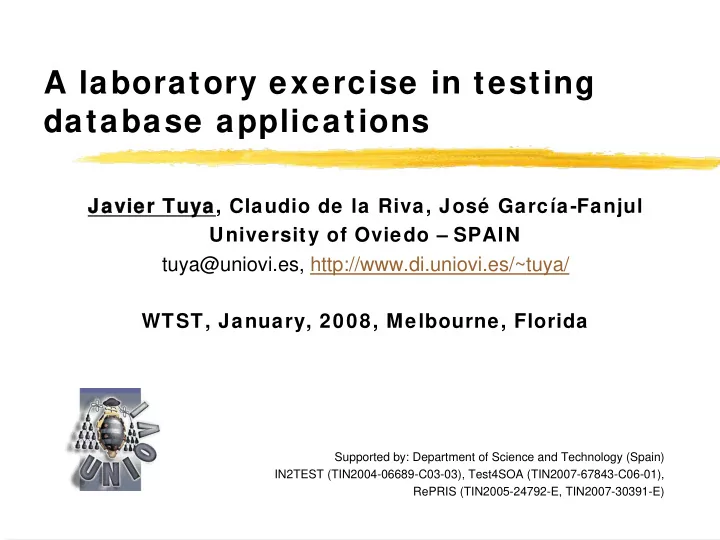

A laboratory exercise in testing database applications Javier Tuya Javier Tuya, Claudio de la Riva, José García-Fanjul University of Oviedo – SPAIN tuya@uniovi.es, http://www.di.uniovi.es/~tuya/ WTST, January, 2008, Melbourne, Florida Supported by: Department of Science and Technology (Spain) IN2TEST (TIN2004-06689-C03-03), Test4SOA (TIN2007-67843-C06-01), RePRIS (TIN2005-24792-E, TIN2007-30391-E)
Scope � Graduate courses in Software Engineering � A module in software testing (concepts, black/white-box tech.) � Exercises using small artifacts (short spect, piece of source code) � Problem: How to get a bigger picture of testing � Laboratory exercise - testing in the context of: � A database application � Working in teams � Functional and unit testing � Test automation � Integration of tools � 12 lab-hours plus homework plus 4+ 2 training J. Tuya, WTST 2008 A laboratory exercise in testing database applications 2
Tested Artifacts - Structure � Application: Payments by direct debit � Two tiers, three modules / tier � Unit of assignment: module User Interface Unpaid Bill Batch Tier Claims Generation Reception Business Bills Bills Received Objects Tier (part 1) (part 2) Batches Support components (already tested) Database J. Tuya, WTST 2008 A laboratory exercise in testing database applications 3
Tested Artifacts – User Interface J. Tuya, WTST 2008 A laboratory exercise in testing database applications 4
Tested Artifacts – Doc & Tools � Documentation: � Work procedures (3 pages) � Work instructions (6 pages) � Use cases (2 pages) � Data model (3 pages) � Tools: � Eclipse with JUnit � CVS � Helpdesk (software bug reporting database) � Clover (code coverage) � Data load support methods (not DBUnit) J. Tuya, WTST 2008 A laboratory exercise in testing database applications 5
Test Process � Assignements student (testing) � 1 business component � 1 user interface component � Three students per project � Roles (alternative) � Tester � Developer � Workflow (controled by the helpdesk system) J. Tuya, WTST 2008 A laboratory exercise in testing database applications 6
Discusion (1) � Before beginning: highly motivating � After beginning: difficult � Specifications do not tell everything: Doc. Fragmented into use cases, database and code. Effort in reading and synthesizing. � Specifications are ambiguous or apparently inconsistent: use cases and method comments use natural language. Effort to remove ambiguities. � No failures are found: but at least the injected faults are present. Effort to develop more effective test cases. � Reported bug are not always understandable: Develop the ability to communicate effectively, failures must be precisely reported in the helpdesk. J. Tuya, WTST 2008 A laboratory exercise in testing database applications 7
Discusion (2) � At the end: good experience � Some issues to discuss. How to effectively teach to avoid: � Irrelevant test cases: no testing the validation of user interface and database fields. Focus on the behaviour of the application and on the database states and changes. � More white-box than black-box (business processes): Source code is available. Some test cases designed only to cover the code, forgetting key issues about the specified behaviour. � Difficulties to automate functional tests (user interface): Overhead imposed by the automation of the test cases often hinders the task of designing good test cases. � Poorly documented and difficult to maintain test cases: Many tests that perform very small database loads using a large amount of source code. � Communication problems: Problem reports without enough information. Overhead in discussions. J. Tuya, WTST 2008 A laboratory exercise in testing database applications 8
Recommend
More recommend